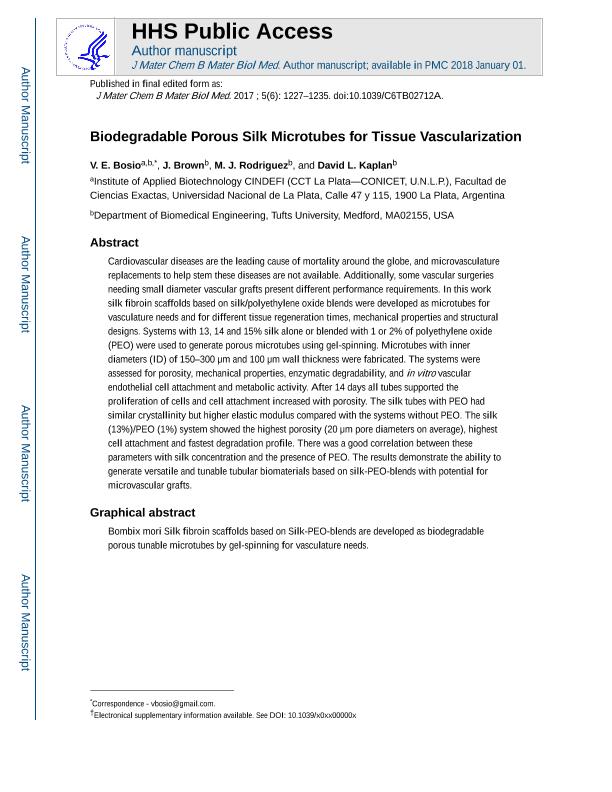Mostrar el registro sencillo del ítem
dc.contributor.author
Bosio, Valeria Elizabeth

dc.contributor.author
Brown, J.
dc.contributor.author
Rodriguez, M.J.
dc.contributor.author
Kaplan, D.L.
dc.date.available
2018-06-19T19:19:48Z
dc.date.issued
2016-12
dc.identifier.citation
Bosio, Valeria Elizabeth; Brown, J.; Rodriguez, M.J.; Kaplan, D.L.; Biodegradable porous silk microtubes for tissue vascularization; Royal Society of Chemistry; Journal of Materials Chemistry B; 5; 6; 12-2016; 1227-1235
dc.identifier.issn
2050-750X
dc.identifier.uri
http://hdl.handle.net/11336/49413
dc.description.abstract
Cardiovascular diseases are the leading cause of mortality around the globe, and microvasculature replacements to help stem these diseases are not available. Additionally, some vascular surgeries needing small-diameter vascular grafts present different performance requirements. In this work, silk fibroin scaffolds based on silk/polyethylene oxide blends were developed as microtubes for vasculature needs and for different tissue regeneration times, mechanical properties and structural designs. Systems with 13, 14 and 15% silk alone or blended with 1 or 2% of polyethylene oxide (PEO) were used to generate porous microtubes by gel spinning. Microtubes with inner diameters (IDs) of 150-300 μm and 100 μm wall thicknesses were fabricated. The systems were assessed for porosity, mechanical properties, enzymatic degradability, and in vitro vascular endothelial cell attachment and metabolic activity. After 14 days, all the tubes supported the proliferation of cells and the cell attachment increased with porosity. The silk tubes with PEO had similar crystallinity but a higher elastic modulus compared with the systems without PEO. The silk (13%)/PEO (1%) system showed the highest porosity (20 μm pore diameter on average), the highest cell attachment and the fastest degradation profile. There was a good correlation between these parameters with silk concentration and the presence of PEO. The results demonstrate the ability to generate versatile and tunable tubular biomaterials based on silk-PEO blends with potential for microvascular grafts.
dc.format
application/pdf
dc.language.iso
eng
dc.publisher
Royal Society of Chemistry

dc.rights
info:eu-repo/semantics/openAccess
dc.rights.uri
https://creativecommons.org/licenses/by-nc-sa/2.5/ar/
dc.subject
Silk
dc.subject
Tissue Engineering
dc.subject
Vascularization
dc.subject.classification
Otras Biotecnologías de la Salud

dc.subject.classification
Biotecnología de la Salud

dc.subject.classification
CIENCIAS MÉDICAS Y DE LA SALUD

dc.title
Biodegradable porous silk microtubes for tissue vascularization
dc.type
info:eu-repo/semantics/article
dc.type
info:ar-repo/semantics/artículo
dc.type
info:eu-repo/semantics/publishedVersion
dc.date.updated
2018-06-19T16:53:17Z
dc.journal.volume
5
dc.journal.number
6
dc.journal.pagination
1227-1235
dc.journal.pais
Reino Unido

dc.journal.ciudad
Cambridge
dc.description.fil
Fil: Bosio, Valeria Elizabeth. Consejo Nacional de Investigaciones Científicas y Técnicas. Centro Científico Tecnológico Conicet - La Plata. Centro de Investigación y Desarrollo en Fermentaciones Industriales. Universidad Nacional de La Plata. Facultad de Ciencias Exactas. Centro de Investigación y Desarrollo en Fermentaciones Industriales; Argentina
dc.description.fil
Fil: Brown, J.. Tufts University; España
dc.description.fil
Fil: Rodriguez, M.J.. Tufts University; España
dc.description.fil
Fil: Kaplan, D.L.. Tufts University; España
dc.journal.title
Journal of Materials Chemistry B
dc.relation.alternativeid
info:eu-repo/semantics/altIdentifier/doi/http://dx.doi.org/10.1039/c6tb02712a
dc.relation.alternativeid
info:eu-repo/semantics/altIdentifier/url/http://pubs.rsc.org/en/Content/ArticleLanding/2017/TB/C6TB02712A
Archivos asociados
